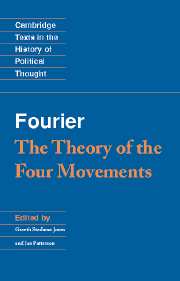Book contents
- Frontmatter
- Contents
- Introduction
- Principal events in Fourier's life
- A brief note on further reading (in English)
- Translator's introduction
- The Theory of the Four Movements and of the General Destinies
- 1808 Introduction
- Preliminary discourse
- Plan
- First part: Exposition of some branches of the general destinies
- General ideas about the destinies
- Phases and periods of the social order in the third planet namely the earth
- Epilogue: On the proximity of the social metamorphosis
- Second part: Description of the various branches of the private or domestic destinies
- Third part: Confirmation derived from the inadequacy of the inexact sciences to deal with all the problems that the civilised mechanism presents
- Omitted chapter
- Note A
- Advice to the civilised
- 1818 Introduction
- Index
- Cambridge Texts in the History of Political Thought
General ideas about the destinies
Published online by Cambridge University Press: 05 June 2012
- Frontmatter
- Contents
- Introduction
- Principal events in Fourier's life
- A brief note on further reading (in English)
- Translator's introduction
- The Theory of the Four Movements and of the General Destinies
- 1808 Introduction
- Preliminary discourse
- Plan
- First part: Exposition of some branches of the general destinies
- General ideas about the destinies
- Phases and periods of the social order in the third planet namely the earth
- Epilogue: On the proximity of the social metamorphosis
- Second part: Description of the various branches of the private or domestic destinies
- Third part: Confirmation derived from the inadequacy of the inexact sciences to deal with all the problems that the civilised mechanism presents
- Omitted chapter
- Note A
- Advice to the civilised
- 1818 Introduction
- Index
- Cambridge Texts in the History of Political Thought
Summary
(The next five preliminary chapters must be read at least twice, and preferably three times, if you want fully to understand the chapters that follow, which will not prove difficult once the first five have been mastered.)
Definition and division
The destinies are the past, present and future results of God's mathematical laws of universal movement.
Universal movement is divided into four main branches: social, animal, organic and material.
Social Movement: this theory explains the laws by which God governs the ordering and succession of the different social mechanisms in all the inhabited globes.
Animal movement: this theory explains the laws by which God distributes the passions and instincts of all created beings, past and future, in the various globes.
Organic movement: this theory explains the laws by which God distributes properties, such as form, colour, smell, etc., to all created or future substances in the various globes.
Material movement: this theory, which has already been explained by modern geometricians, has taught us the laws by which God governs the gravitation of matter on the various globes.
There is no effect of movement which is not included in one or other of these four divisions; together they make up universal movement of which we only know about the fourth branch, material movement. Even this has as yet only been partially explained, as the geometricians, in pointing out the laws of the existing order of the stars, fail to take account of the changes the vortices of stars under went a hundred thousand years ago, and the changes they may undergo in a hundred thousand years' time.
- Type
- Chapter
- Information
- Fourier: 'The Theory of the Four Movements' , pp. 36 - 39Publisher: Cambridge University PressPrint publication year: 1996



